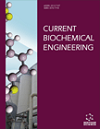- Home
- A-Z Publications
- Current Biochemical Engineering (Discontinued)
- Previous Issues
- Volume 2, Issue 1, 2015
Current Biochemical Engineering (Discontinued) - Volume 2, Issue 1, 2015
Volume 2, Issue 1, 2015
-
-
Process Analytical Technology (PAT) and Multivariate Methods for Downstream Processes
More LessAuthors: N.N. Misra, Carl Sullivan and P.J. CullenThe stringent requirements and high cost involved in the production of biomolecules from pharmaceutical, food and speciality chemical industries demand appropriate real-time process monitoring and control for downstream processes. Process analytical technology (PAT) is now an established concept for process monitoring and quality compliance in the pharmaceutical industries and is rapidly gaining importance in the bioproc Read More
-
-
-
Production and Purification of Heterologous Candida antarctica lipase B Expressed in Pichia pastoris: A Systematic Literature Review
More LessAuthors: Premsingh Samuel S D and Balu PThis article review strategies for Candida antarctica lipase B (CALB) production in Pichia pastoris expression system and the techniques used for separation and purification of CALB. Due to ease of purification, most researchers prefer to express CALB as extracellular product. Though, CALB is secreted into growth medium, it is significant to recover target protein with minimal loss. Protein purification involves sequence of steps Read More
-
-
-
Supercritical Fluid Extraction of Functional Ingredients From Plants: A Review
More LessAuthors: K.V. Chaitanya, Ch. Rama Krishna, Sk. Khasim Beebi and K. DivyaCompounds extracted from plants with biological activity are the subject of interest for their role in the pharmaceutical and nutraceutical industries. Extraction of these compounds has been traditionally done using conventional methods using organic solvents and applying stringent conditions such as high temperatures resulting in the decrease of yield and purity. Developing alternative ecofriendly extraction techniques with be Read More
-
-
-
Osmotic Membrane Distillation in Downstream Processing
More LessAuthors: B. Ravindra Babu and J. SambasivaraoBioseparation and downstream processing occupy a complex and important position in biotechnology and biochemical engineering. Purification and concentration of biological materials requires new approaches that are gentle enough to protect the biological activity. Osmotic membrane distillation (OMD) is an interesting alternative for the concentration of thermoliable compounds at ambient temperature and atmospheri Read More
-
-
-
Aqueous Two-phase Extraction in Downstream Processing
More LessAuthors: M.C Madhusudhan, N. Amrutha, Anupama Rani and KSMS RaghavaraoAqueous two-phase extraction has been effectively used for the separation and purification of several biological molecules. The main advantages of aqueous two-phase extraction are biocompatibility, scope for continuous operation, process integration and ease of scale up. In downstream processing, aqueous two-phase extraction has found its applications in extraction, purification and concentration of various biomolecule Read More
-
-
-
Drying as a Unit Operation in Downstream Processing
More LessAuthors: Kehinde Taiwo and N. AmruthaConsumer demand has increased for processed products that keep more of their original characteristics. Downstream processing refers to the purification of biological products, generally in marketable quantities especially in the production of biomolecules such as antibiotics, hormones, antibodies, vaccines, industrial enzymes, natural fragrance, flavor compounds. There have been various advances in drying with respect Read More
-
-
-
Downstream Processing of Bioactive Compounds from Milk and Whey
More LessAuthors: Rupesh S. Chavan, Prabhat K. Nema and Vijendra MishraBioactive peptides are specific protein fragments that have a positive impact on functions and conditions and may ultimately influence health. Milk protein derived active biological constituents, bioactive peptides, has received much attention for the biological significances. Milk peptides have shown to possess multiple physiological and physicochemical properties and are therefore regarded as very important constituents for i Read More
-
-
-
Interactive Effect of Agitation Speed and Aeration Rate on Heat Stable β- carotene Production From Mucor azygosporus Using Deprotenized Waste Whey Filtrate in Stirred Tank Reactor
More LessAuthors: Wamik Azmi, Meenu Thakur, Azhar Javed and Neetika ThakurInteractive effects of aeration rate and agitation speed on β-carotene production by Mucor azygosporus using waste whey filtrate in a laboratory fermenter were studied. The maximum β-carotene concentration (1045 µg/g dcw) was obtained at low agitation speed (150 rpm) and moderate aeration rate (1.0 vvm) after 72 h of incubation with a biomass of 7.9 g/L. The agitation and aeration provided better homogeneity in th Read More
-
-
-
Trichothecin from Endophytic Fungus Trichothecium sp. and its Anticancer Effect on Murine Melanoma and Breast Cancer Cell Lines
More LessEndophytic fungi were isolated from the leaves of medicinal herb Phyllanthus sp. sourced from different areas of Pune and then screened for Trichothecin production. Out of 30 endophytic fungal cultures isolated and screened, only one AAP-PS-1 was found to produce Trichothecin extracellularly in appreciable amounts and was identified as Trichothecium sp. by morphological, cultural and molecular methods. Tricho Read More
-
-
-
Biodegradation of Diethylketone by Penicillium sp. and Alternaria sp. – A Comparative Study Biodegradation of Diethylketone by Fungi
More LessAuthors: Filomena Costa, Marta Neto, Ana Nicolau and Teresa TavaresTwo contaminating fungi were isolated from a bioreactor containing diethylketone and Streptococcus equisimilis, subsequently characterized at molecular level and identified as belonging to the Alternaria and Penicillium genera. The ability of these fungi to biodegrade DEK is evaluated. The kinetic parameters are estimated using four growth kinetic models for biodegradation of organic compounds available in literature. The Read More
-
-
-
Physico-chemical Characterization of Exopolysaccharides of Potential Probiotic Enterococcus faecium Isolates from Infants’gut
More LessAuthors: Bijender Kumar Bajaj, Konika Razdan, Ingmar JJ Claes and Sarah LebeerMicrobial exopolysaccharides (EPS) may have technological applications in food and pharmaceutical industries, and in environmental health. EPS may be used in foods as natural thickening, stabilizing, bodying or gelling agent, and/or as emulsifiers or as fat replacer. In addition, EPS has been reported to have health augmenting features such as prebiotic, immunostimulatory, anti-tumor and hypocholesterolemic properties. EP Read More
-
Most Read This Month
Article
content/journals/cbe
Journal
10
5
false
en


